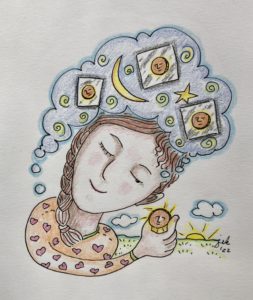
From a biological point of view, a habit is a well-connected cluster of brain cells (neurons) that form a circuit that, when turned on, directs the body and mind to automatically behave in a certain way. Many habits are inherited through the arrangement of genes in our DNA, and many are formed epigenetically, as we learn new things post-birth.
A distinguishing characteristic of a habit is that it operates outside of consciousness. Our body is frequently prompted to perform habits while the attention of our conscious mind is far away, in thought. Think about driving and suddenly noticing that you have arrived at your destination with little memory of the journey.
Habits are housed in the subconscious mind, which pairs the suggestions it receives through sensory triggers with its storehouse of habitual responses. The subconscious largely runs all the systems of our body independently of our awareness.
Habits are the building blocks of our identity. When we awaken from our night sea journey of sleep, we are quickly swept away from dreamland and placed into the familiar story of who we are in waking life. Thoughts of our upcoming day become the triggers of our mental habits that tell us who we are.
“What is the time? Oh, I always wake up late, I never give myself enough time (depressed feeling). I won’t have time to eat (sad). I’ll grab a coffee at the gas station because, of course, I didn’t fill up yesterday because I was lazy, as usual (defeated). Oh! I have that meeting today; I hate presenting (anxiety). I feel so judged by my peers, especially by her, Miss Perfect (failure). I hate this job, but I’m stuck (not good enough)…”
We think about 60,000 thoughts a day, 90% of which are habitual. This string of thought-triggers, that begins upon awakening, becomes a nonstop internal dialogue that solidifies our sense of who we are, providing us with our familiar identity. Whether we like ourselves or not, we find comfort in the secure grounding and dependability of our habitual definition and feeling of self.
The good news, from a neurological point of view, is neuroplasticity, the capacity of the brain to establish new neural networks, and consequently, new habits. New thoughts can be consciously chosen, which, when repetitively stated and imbued with imagination and emotion, provoke the subconscious to manifest a new identity and a new physical reality. (See link below.)
The brain treats our thoughts as actual reality. When we imagine something in our minds, the brain creates new circuits of neurons and chemical reactions that build new physical structures and emotions in the body, in accordance with the model we mentally create. When the mind rehearses its desired future, the brain builds the structures to make it physically happen.
The challenge to suggesting new thoughts to the subconscious, as Dr. Joe Dispenza points out, is that we must allow ourselves to be uncomfortable with change. Our attachment to the comfort of our familiar, known, habitual self generates defenses to protect its prior habitually-established neurocircuitry.
Subjectively, this is experienced as doubt and lack of faith in the ability to truly transform the self, mentally and physically. The tendency is to continue to place emphasis on the known, reinforcing the hegemony of the old circuitry. As Christ pointed out, without faith there are no miracles. He was not talking about faith in him but faith in the ability of the self to truly transform. That’s the suggestion necessary to get the attention of the subconscious.
The nuts and bolts of transformation is rote practice, continued over time. Say something enough times with passion, while imagining it, and it will come to pass. That’s exactly how the inner dialogue already works: we become what we think. If we take conscious control of directing our thoughts, we change our brain and we change who we are.
The challenge is both perseverance and a willingness to live in the discomfort of a fluid rather than a fixed identity. To grow, in its fullest potentiality, is to arrive at the perspective of all that is, better known as, the ultimate experience of cosmic oneness.
At the gross motor level of the physical body, the shamans of ancient Mexico used not-doings to break the fixation of habitual behavior, awakening consciousness to be able to choose new behaviors. A not-doing might be to change your bedtime every night or to wear mismatched socks during the day. Spontaneous decisions, like breaking into singing and dancing or choosing a different turn while driving, disrupt habit and awaken consciousness.
Life in Earth School paradoxically requires us to establish a uniformity of identity through a habitual self to feel safe and grounded, yet it also insists that we constantly break old habits of self in order to grow.
Life in Graduate Earth School asks us to wake up and be the rising sun each morning, like the phoenix burning off the habitual self of just yesterday, as we journey further into the adventure and discomfort of the unknown in a new day.
Nothing can ever stay the same. Habits are all temporary perches from which to observe and discover infinity. Enjoy them, learn from them, but don’t get too attached, as more of infinity awaits!
Not Doing,
Chuck
Sharing a good meditation to support a changing self, created by Dr. Joe Dispenza. I suggest listening to it in its entirety, many times, for the fullest experience.
You are the Placebo-Guided Meditation



